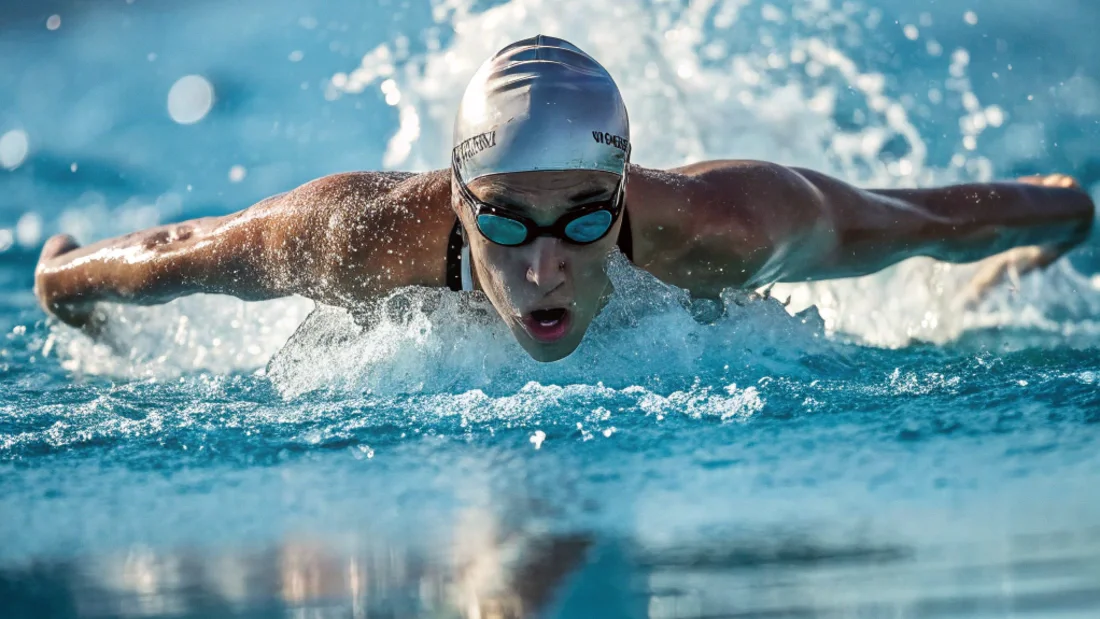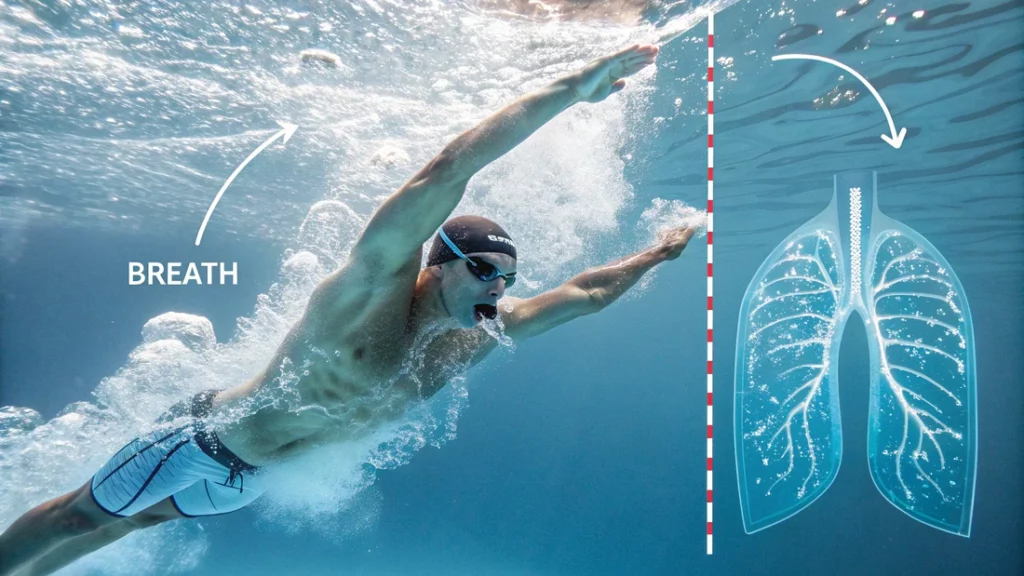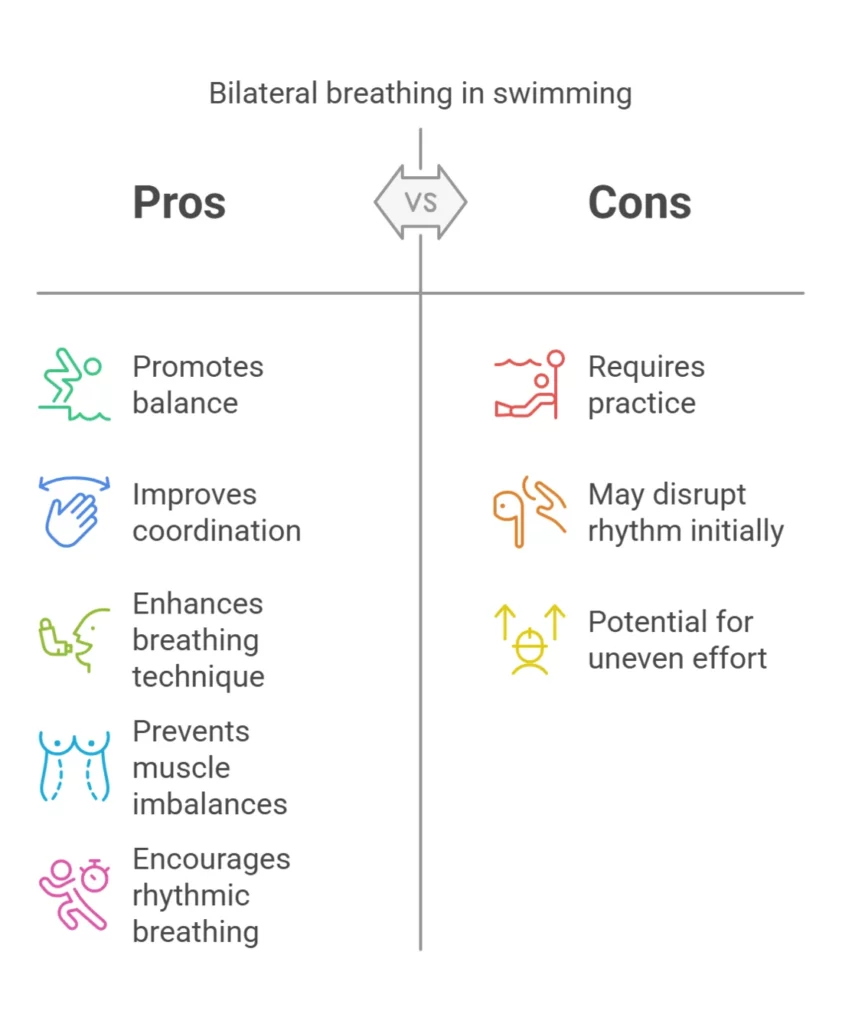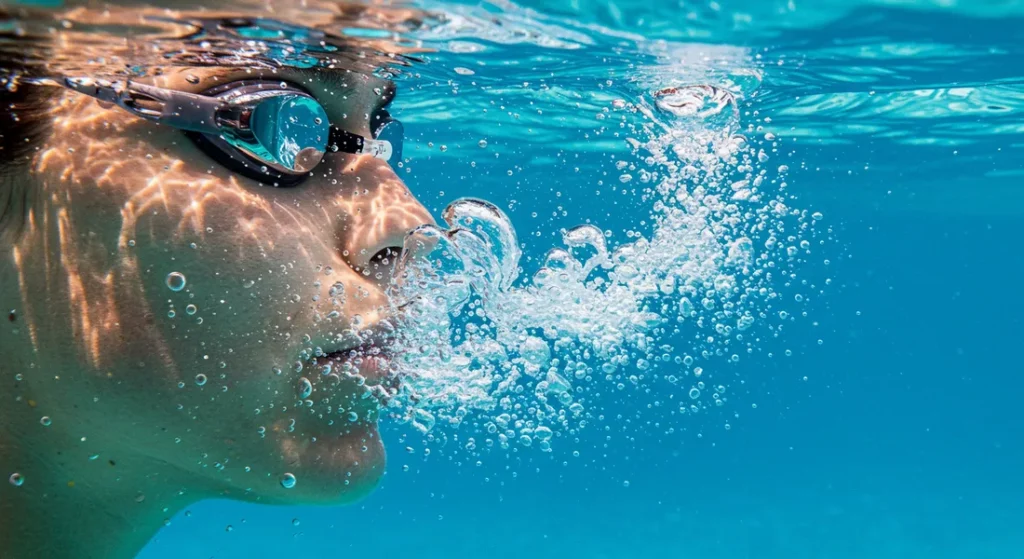Are you a swimmer constantly battling fatigue, struggling to improve your speed, or feeling like you can’t quite master that perfect stroke?
While countless hours in the pool are essential, it’s also important to understand the subtle art of proper breathing.
Breathing techniques for swimming are often overlooked, yet they are vital for unlocking your true athletic potential in the water.

It’s true that mastering the stroke is important, but it is also important to learn how to breathe during your stroke.
If you find that you are working so hard and not improving, then you may not have mastered the key concepts of breathing.
If you are ready to harness the power of breath to transform your performance, speed, and endurance, then this blog is definitely for you!
Why Proper Breathing Is Vital For Swimming Performance
To unlock your full potential in the water, it’s essential to first understand why breathing is not just an involuntary action but a key determinant of your swimming success.
Breathing forms the very foundation for everything that you do in the pool.
Learning why proper breathing is important will form a good base for your fitness journey.

Key Aspects of Breathing in Swimming:
- Role of Breathing in Swimming:
- In swimming, breathing serves several vital functions. It not only provides oxygen to power your muscles, but it is also critical for your stroke, rhythm, and overall body position. Without proper breathing, you will find it very difficult to maintain a consistent level, to power through your workout, and to reach your true potential.
- Common Challenges of Breathing While Swimming:
- Many swimmers struggle with balancing the need to breathe with maintaining a streamlined body position. It takes practice to find a comfortable method for rotating and breathing without disrupting your body position. In addition, many struggle to control the amount of oxygen they take in, and also with coordinating their breathing pattern with the movement of their limbs. All of these issues can be rectified with consistent practice and the right support.
- Overcoming These Challenges:
- Fortunately, with mindful practice and the right techniques, these challenges can be easily overcome. By becoming more aware of your body, and by implementing clear breathing practices, you will not only enhance your overall swimming performance but will also improve your control and endurance.
- All that is required is a willingness to practice, and a dedication to making improvements, both in your mind and in your body.
Key Breathing Techniques for Enhanced Swimming
Now that we have explored the importance of breathing, let’s take a look at the specific breathing techniques that can elevate your swimming performance.
Each of these techniques is designed for a specific purpose, and each will also provide you with valuable tools to help improve your overall swimming journey.
Techniques
- Bilateral Breathing:

- Description: Bilateral breathing involves alternating your breathing pattern to both sides of your body, instead of consistently breathing on just one side. This will promote balance and coordination during your workouts.
- How to Perform:
- Swim your normal stroke technique.
- On your third stroke, turn your head to one side to take a breath, and ensure that you are still moving at a steady pace.
- Continue to swim as normal, and then take your next breath on the opposite side.
- Remember to always breathe on the third stroke, so that it remains as consistent and rhythmic as possible.
- Benefits: Bilateral breathing helps to promote a more symmetrical stroke, and will also help to improve your overall breathing method. It also forces you to not only breathe on one side of your body which will help to strengthen each side equally and to avoid any muscle imbalances.
- Rhythmic breathing:
- Description: Rhythmic breathing is a practice that focuses on taking a consistent and regular breath pattern, to allow you to perform to your best ability. This method will help you to manage your energy, and also to take control of your fitness.
- How to Perform:
- Choose a specific number of strokes and then ensure that you are taking a breath when you reach that number.
- For example, you may choose to breathe every three strokes, or every five strokes, but make sure that you are taking regular, deep breaths to make the most of this.
- You can also focus on exhaling the same amount of oxygen that you inhale to make this a consistent cycle.
- Benefits: Rhythmic breathing is great for improving your oxygen supply to the muscles, and also helps to improve control. By making a conscious effort to take the same breath, you are also improving muscle performance and creating consistency.
- Exhalation Control:

- Description: Controlling your exhalation during swimming is key to making the most of your inhalations. To do this, you need to exhale slowly and completely, so that all of the bad air has left your body and you are ready to take on a new breath.
- How to Perform:
- When you turn to breathe, exhale completely to remove any trace of air from your lungs.
- Then, when it is time to inhale, your lungs will be fully empty and ready to take on as much oxygen as they can hold.
- Focus on letting go of any tension, as you exhale, to allow your body to feel relaxed, and open for more oxygen.
- Benefits: By fully exhaling, you are improving your body’s ability to take in oxygen and create new energy. This is vital for improving performance and ensuring that you can make the most of your swimming workouts.
Integrating Breathing into Your Swimming Routine
Understanding the techniques is only half the battle.
It is also vital to learn how to practically implement them into your swimming routine, to ensure that you are getting the most out of your workouts.
Here is a rundown on how you can enhance your swimming with these different methods.

Applying Breathing Techniques to Different Swimming Styles
- During Different Strokes:
- Each swimming stroke may require a unique breathing pattern to ensure efficiency and coordination. For example, in freestyle, many swimmers breathe every three strokes, alternating sides to maintain balance. In breaststroke, breath is often taken during the arm recovery phase. For backstroke it is recommended to breathe in one direction, and out the other. This will depend on the individual, but it is vital to test out which is most suitable for your stroke.
- It is also important to test out which method feels the most natural for you, and not to force anything that feels unnatural or wrong.
- During Sprint Training:
- When you are performing sprint training, it is vital that you are getting as much oxygen as possible. You may need to breathe more frequently and potentially even breathe through your mouth, if you are starting to get tired. With this being said, it is very important to exhale fully to allow your lungs to perform at their best.
- You also may not want to be overthinking your breathing, but instead, focus on moving as fast as possible, which can naturally create a good rhythm.
- During Endurance Training:
- In longer swimming activities, the key is to maintain a consistent and sustainable breathing pattern, to allow your body to keep going for as long as possible. It is very important to make sure you are pacing yourself, and that you are breathing from your lungs, and not just your chest. Practicing belly breathing techniques may be particularly helpful for you.
- If you are able to maintain a steady, mindful and consistent rhythm, this will help you to continue for longer, and to also prevent your body from feeling fatigued.
Practical Tips for Effective Breathing
While understanding the science of breathing and exploring the different techniques is crucial, let’s dive into the practical steps you can take to make these methods a success in your swimming routine.
These tips will provide a solid foundation for your fitness journey, and will assist in you creating sustainable habits for your life.
Key Tips
- Start Slowly:
- When you are starting with new breathing patterns, make sure that you are easing into the process and not putting too much pressure on yourself. You want this process to be enjoyable and sustainable, so it is important to listen to your body and only do what you are comfortable with.
- If you feel any discomfort, stop what you are doing and take a break. There is no need to rush the process and you will get there in your own time. Allow yourself to ease into it gently.
- Be Consistent:
- Just like any fitness journey, consistency is key to seeing success with implementing new breathing patterns. It is far more beneficial to spend a few minutes each day focusing on your breathing, rather than one longer session every month.
- If you can make a habit of focusing on your breathing every time you are in the pool, you will find that this becomes more natural and easy, overtime.
- Listen to Your Body:
- You know your body better than anyone else, so it is important that you listen to it when implementing new breathing methods. Only you know when you are feeling too pushed, or if you need to take a break. Taking the time to understand your needs is a vital part of this journey.
- Pay attention to any signals your body might be sending, and respect what it needs. It is okay to rest, to take time and to change the method, if your body is asking you to. By taking a mindful approach to this technique, you are more likely to succeed.
- Be Patient:
- When learning any new skill, it is important to be patient, and not put too much pressure on yourself. Know that it takes practice, and it also takes time to develop, so it is important to implement a slow and steady approach. Try not to compare yourself to others, and instead focus on your own journey, celebrating your wins, and taking it one day at a time.
- By committing to a steady journey, you are setting yourself up for long-term change and also enjoyment.
Frequently Asked Questions About Breathing For Swimming
To better equip you with the right knowledge to improve your swimming technique, I have put together a list of frequently asked questions.
These are some of the most common queries that swimmers have, and I believe that by reading these, you will come away with a much better understanding of this topic.
- Question 1: How to breathe while swimming freestyle?
- Answer: When swimming freestyle, you should aim to breathe every three strokes, by alternating sides to maintain balance. As you turn your head, you should then fully exhale, before inhaling again on the next stroke. This coordinated approach will help you to conserve energy, and also improve your speed and technique.
- Question 2: What is bilateral breathing in swimming?
- Answer: Bilateral breathing is a method of breathing in freestyle, which involves breathing on alternate sides of your body, rather than just one. It helps to improve symmetry, balance, and also promotes a more fluid and efficient stroke technique. By implementing bilateral breathing, you are giving your body the chance to engage more effectively, and it will also reduce the risk of injury.
- Question 3: How to exhale when swimming?
- Answer: Efficient exhalation is just as important as effective inhalation. You want to make sure that you are exhaling fully when you are in the water, to allow your body to take on as much oxygen as possible. You should use a controlled exhale through both your mouth and your nose when your face is submerged in the water. Once you are used to this, it will become a natural part of your routine.
- Question 4: How can I improve my breathing in swimming?
- Answer: The key to improving your breathing in swimming is to focus on the different techniques that are being used, and to remain patient as you implement them. Start by being aware of your current methods, and the limitations that you may have, and then begin to try out belly breathing, paced breathing and exhalation control, to see which ones resonate with you and your body. Over time, these techniques will become natural and you will start to see significant improvements in your speed, endurance and stroke.
Final Thoughts on Breathing Techniques for Swimming
As we come to the end of this comprehensive guide, I hope you now understand that effective breathing is an art, and it is something that can take your swimming to the next level.
Whether you are training for a competition, or simply wanting to enhance your overall health, understanding the importance of breathing is key.
Throughout this blog post, we have explored the vital role that breathing plays in swimming, we have also addressed some common mistakes, and also taken a look at some techniques that can greatly enhance your journey.
You should now feel fully equipped to make positive changes to your breathing technique, so you can reap the long-term benefits.
My final tip is to try to be consistent, to stay patient with yourself, and also to enjoy the process.
Breathing is not only about enhancing your performance, but it can also be used as a mindfulness practice, and as a way to connect with your body and the present moment.
I encourage you to implement these techniques into your routine and to see just how much these methods can change your life.
Now, go forth and breathe!
References
1. The Effect of Breathing Patterns Common to Competitive Swimming on Gas Exchange and Muscle Deoxygenation During Heavy-Intensity Fartlek Exercise:
- Link: https://pmc.ncbi.nlm.nih.gov/articles/PMC8652135/
- Source: National Institutes of Health (NIH) (.gov)
- Why it’s Credible: This study compared the respiratory and muscle deoxygenation responses of regulated breathing vs. free breathing
2. Should You Breathe to Both Sides in Freestyle?
- Link: https://www.usms.org/fitness-and-training/articles-and-videos/articles/should-you-breathe-to-both-sides-in-freestyle
- Source: U.S. Masters Swimming
- Why it’s Credible: There’s some wisdom in bilateral breathing. Here are some compelling reasons why you shouldn’t only learn it but also practice it on a regular basis.
3. Freestyle Breathing: The Complete Guide
- Link: https://www.usms.org/fitness-and-training/guides/freestyle/breathing
- Source: U.S. Masters Swimming
- Why It’s Credible: This is a website that shows how to breathe properly while swimming and provide some drills and sets that’ll help you to breathe easy..
Related Posts
No posts
